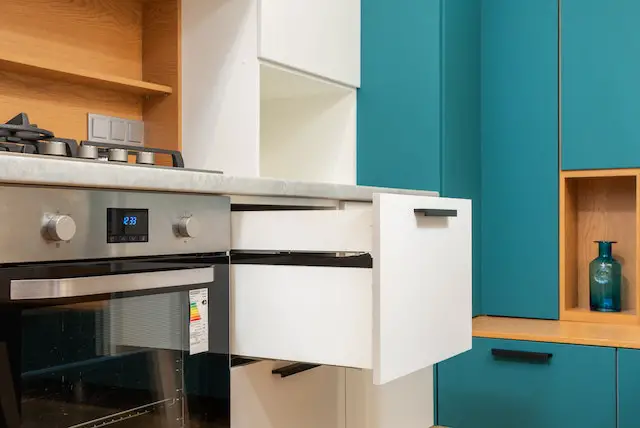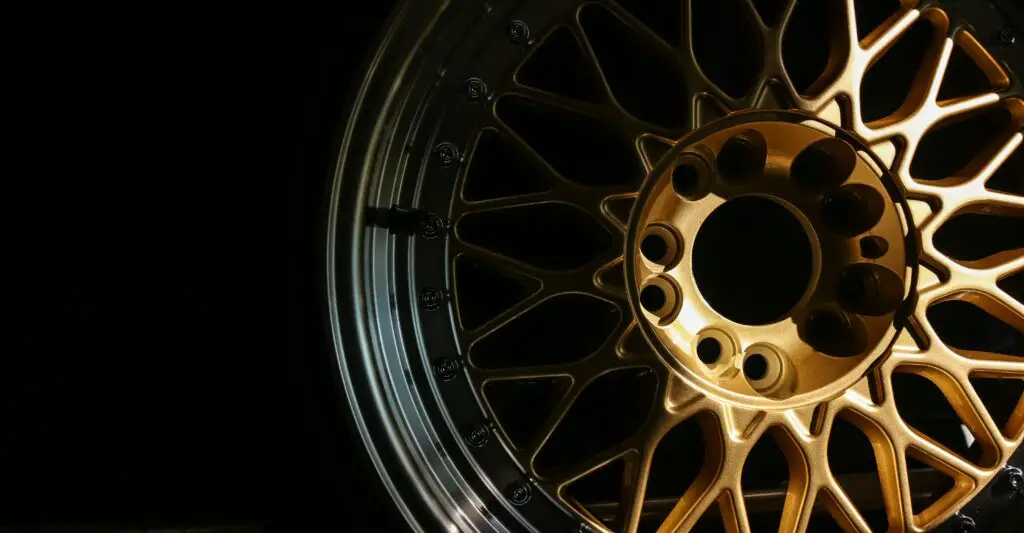Nothing beats the look of a clean and sparkling kitchen, but worn-out kitchen cabinets can overshadow the most gleaming countertops. The solution? Spray painting kitchen cabinets to transform your culinary haven into an aesthetically pleasing cookhouse.
However, painting kitchen cabinets isn’t a one-day job but requires you to set aside at least a week to complete the project perfectly. So be prepared to eat lots of take-out food.
Start by covering your workspace because spray painting your kitchen cabinets can get messy. Clean all the surfaces with a degreaser and sand the cabinets to create a good base for the primer. Apply a thin layer of a suitable primer followed by 2-3 coats of color.
There are several guides for spray painting kitchen cabinets across the internet, but do they actually work? I will discuss painting steps and pro tips and tricks to help you achieve results your neighbors will envy.
Can You Spray Paint Old Kitchen Cabinets?
If your kitchen cabinets are old and screaming for a makeover, spray painting is the best option. Especially if you are not in the mood for overspending your monthly budget on costly replacements.
The highlight of a DIY painting project is that you can immediately create a noticeable change without investing too much money and time. In addition, opting for a completely new color or high-contrast combination greatly impacts how your kitchen looks and feels.
While the short answer to: Can you spray paint wood kitchen cabinets is yes, you must remember that not all kitchen cabinets are worth your time and effort. So, before you break out the roller, check the condition of your cabinets to be sure they can be saved with just paint.
A few small chips or cracks here and there can be easily fixed with wood filler, but if the woodwork is warped or the veneer is peeling, you might be better off replacing the beat-up drawer fronts and doors with new ones.
Pro Tip: Oak cabinets and other coarse-grain wood species cannot be spray painted smoothly. To get an even base, you must fill the grain on the door panels, cabinet frames, and sides with spackling compound.
Can You Use Canned Spray Paint for Kitchen Cabinets?
Canned spray paints are efficient and provide the cleanest and smoothest finish, making them an excellent candidate for kitchen cabinets. However, spray painting kitchen cabinets with cans means you will need a lot of them to cover all surfaces, which is not exactly budget-friendly.
There are other applicator options like rollers and paint brushes, but they either consume too much paint or offer a streaky finish in the hands of an amateur. The best way to paint your kitchen cabinets is with a professional-level sprayer like the Home Right Finish Max Paint Sprayer.

I understand these sprayers are on the pricier end, but if you are a DIY paint enthusiast, they might turn out to be the best investment you can make. However, if you want to renovate your kitchen on a budget, you can always get a sprayer on rent from a hardware store and get the job done.
If you’re still confused between using a paintbrush, roller, and sprayer, this battle of the applicators should definitely help!
Pro Tip: Buy a respirator mask for protection if you plan to use a professional paint sprayer.
What Type Of Paint Is Ideal For Kitchen Cabinets?
The best spray paint for kitchen cupboards would depend on the surface you’re working with.
As each type of paint is formulated differently, what works on one surface may offer different results on another. As a rule, you should avoid acrylic and oil-based paints when painting kitchen cabinets made of vinyl, acrylic, or plastic.
Alternatively, solvent-based paints adhere perfectly to timber, plastic, and vinyl cabinets.
Both latex and oil-based paints offer a great finish; however, the improvement in latex paint formulations over the years has made many professionals ditch the traditional oil-based paints for their water-based counterparts.
Latex paints have quick drying times, are easier to clean up, and are much more forgiving than oil paints in terms of paint application. But no one can argue with the increased durability of oil paints.
While oil-based paints are more expensive and less user-friendly, they do a much better job hiding any imperfections in your cabinets. Moreover, they don’t shrink as much as they dry, which means what the paint looks like wet is what it will look like dry.
I recommend finding the best temperature and humidity for interior painting to get the best results on your kitchen cabinets.
How To Spray Paint Kitchen Cabinets

Now that we’ve discussed the paint formulation and applicator best suited for your kitchen cabinets let’s move on to the application process.
Step 1: Inspect Your Kitchen Cabinets
While it’s easy to get carried away with the excitement of a DIY project, slow down to check the condition of your kitchen cabinets.
You should look for any chips or cracks that need to be repaired with wood filler, as that will be the deciding factor between a patched-up job and a flawless one.
Step 2: Prepare Your Workspace
If you plan to use a professional paint sprayer for your cabinets, be warned that the paint will get everywhere, and I mean everywhere! So unless you want your countertops, roof, and side walls to get an unexpected paint job of their own, prep the surface thoroughly.
Here’s a quick checklist you can follow:
- Empty the cabinets
- Clear the counters
- Move any furniture that is in the way
- Clean the room thoroughly to ensure dust particles or pollen don’t stick to the wet surfaces.
- Cover the counters, backsplash, and floor with plastic sheets and secure with painter’s tape.
Step 3: Remove The Doors and Hardware
Did you think covering your workspace was enough? There’s plenty of prep work to be done, so stay with me.
Remove the cabinet doors using a drill or manual screwdriver, and get rid of all cabinet hinges, drawers, and hardware while you’re at it. Although you may feel like going rogue on this step, it will allow you to access all parts of the cabinet and achieve a professional finish without cutting corners.
Pro Tip: Number each cabinet door as you take them off and place its hardware in a small bag with the same label. You will thank me for this tip once you start reassembling your kitchen cabinets.
Step 4: It’s Time To Sand!
Typically I would ask you to clean, strip, and sand the surface until your back starts hurting, but there are quicker ways to get the same results, thanks to advancements in the home improvement industry.
Simply go over all the surfaces you want to paint with liquid sandpaper and create a good base for the primer to bond. You can also use the M-1 Pre-Paint Cleaner and Gloss Remover to rid the surfaces of dirt, grime, and oily residue.

You should patch up any holes and cracks with wood putty by this time and sand them once dry so the repair doesn’t show through the paint.
Pro Tip: Avoid using TSP or silicone-based cleaners because they can create fisheye on the cabinets, which is a nightmare to paint.
Step 5: Apply Primer
Kitchen cabinets experience a lot of wear and tear and must be cleaned every few days. This is why ensuring your paint job resists all the culinary and cleaning stress is exceedingly important.
You can learn more about what paints are washable to pick the right one for your project.
Select a primer according to the material of your cabinets and apply a thin layer with a brush, roller, or sprayer. Don’t be alarmed if the results look like the work of an 8-year-old; the coverage does get better with each coat of paint.
You should match the primer’s hue with the paint coat’s color for best results. So, if you plan to paint the cabinets white or any other light color, go for a white primer, but if you intend to use deeper colors, you’ll be better off with a darker primer.
Pro Tip: Most latex primers and paints must be thinned down for an HVLP sprayer. You should follow the sprayer manufacturer’s instructions to get the right consistency.
Step 6: Let’s Paint
Once the primer is dry, which generally takes around 40 minutes, start applying the paint in thin layers keeping a steady hand.
If you’re using a brush, avoid too many brush strokes, or you may create air bubbles that dry down to nasty bumps. If rollers are your preferred tool, start from the inside edges of the face frames to the outer cabinets and fronts. This will give you enough time to roll on larger flat surfaces while they’re wet.
If you’re using a paint sprayer, make sure your cabinets are placed in a well-ventilated area. You can even turn on the fan to diffuse the fumes as you spray, and don’t forget to wear your respirator mask! In case you do end up accidentally inhaling the fumes, make sure to clear your lungs of spray paint.
One step that most DIYers tend to skip is sanding between paint coats. Once your first coat of paint is dry, lightly sand all surfaces with soft sandpaper and clean the sanding residue with a tack cloth. Then spray your second coat and repeat the process with each layer.
Pro Tip: Two coats of paint are enough to get decent coverage, but you can always apply a third layer to make the finish more durable.
Step 7: Put Everything Back In Place
If you’re tempted to check whether the paint has dried, try to resist the urge unless you want fingerprints on your finished project.
Allow the paint to cure for at least 48 hours before reassembling the kitchen cabinets.
You can even accessorize your newly painted cabinets with contemporary hardware to elevate their look. The basic idea should be to create contrast. For example, you can pick darker hardware in bronze or black for lighter cabinets and brass or nickel for deeper cabinet hues.
How Much Does Spray Painting Kitchen Cabinets Cost?
The cost of spray painting your cabinets depends on labor and materials.
If you decide to tackle the painting project yourself, you can save the labor costs altogether but remember that you’ll need 20 or more hours to paint an average-sized kitchen.
On the flip side, getting services from ‘professional spray painting kitchen cabinets near me’ save you from paying for other materials like a paint sprayer, roller, drop cloths, tools, etc.
The average cost to paint kitchen cabinets is $775, but it can go up to $2,500 for a large, luxurious kitchen. Subsequently, homeowners can paint their kitchen cabinets themselves, spending as little as $200 on paint and supplies for a small kitchen.
Whether you opt for the DIY option or professional services, repainting your kitchen cabinets will cost less than replacing them, as new cabinets range between $3,000 and $25,000.
Can You Spray Paint Laminate Kitchen Cabinets?
Yes, absolutely!
Spray paints deliver excellent results on laminate, wood laminate, wood, veneer, fiberboard, and even metal. But if you’re dealing with plastic laminate and thermofoil cabinets, you may need specialized paints and techniques to ensure the paint sticks to the surface.
Since it can be confusing for beginners to determine the material of their cabinets, I would advise you to remove a door or drawer and bring it into a paint store for inspection. But if you don’t want to go the extra mile, paint a small area of the cabinet, preferably one not in plain sight, to check if it adheres to the surface.
Can you spray paint melamine kitchen cabinets?
Melamine has a smooth, shiny surface, meaning the paint can have difficulty adhering to it. However, that can be easily fixed with a primer designed for melamine surfaces and 120-grit sandpaper.
Start by sanding the surface to roughen up the top layer but don’t go overboard because you don’t want to remove the material entirely. Rough things enough so that melamine has something to adhere to, and clean the residue with a tack cloth.
Remember to apply a generous layer of primer to give the melamine cabinets a fair chance to bond with the paint. Sand the surface once the primer is dry because bonding primers tend to leave a rough surface.
Pro Tip: Melamine takes longer to dry because it doesn’t absorb any moisture. So, allow your primer extra time to dry before applying the paint coat.
FAQs
Can you spray paint gloss kitchen cabinets?
Yes, you can spray paint glossy kitchen cabinets, but you must prepare the surface by filling in any cracks and holes with a wood filler, followed by a primer like the ZINSSER Primer & Sealer that creates a durable foundation for the paint coat.
Can you spray paint MDF kitchen cabinets?
You can spray paint MDF kitchen cabinets, but the results can be patchy if you don’t prepare the surface well. MDF tends to soak up paint, which means you spend more money but still get a blotchy finish. The best way to avoid this is to use a shellac primer like the ZINSSER Bulls Eye Shellac so the paint doesn’t sink into the surface and delivers an even, smooth finish.
Can you spray paint vinyl kitchen cabinets?
Yes, you can quickly spruce up the appearance of your vinyl kitchen cabinets with a fresh and contemporary paint color. But you must use an adhesion-promoting primer, sand between each primer, and paint coat for long-lasting results.
Can you use Rustoleum spray paint for kitchen cabinets?
Rust-Oleum spray paint is a reliable choice for painting kitchen cabinets, but it’s best for small repairs and touch-ups since one can only covers about 20 square feet.
Conclusion
Nothing beats the look of fresh paint, whether you color the interior walls of your home or revamp your kitchen cabinets. DIY painting jobs are rewarding because you can save some major bucks and also feel super proud of the results. So, take the leap, follow my instructions, and paint your kitchen cabinets like a boss.


